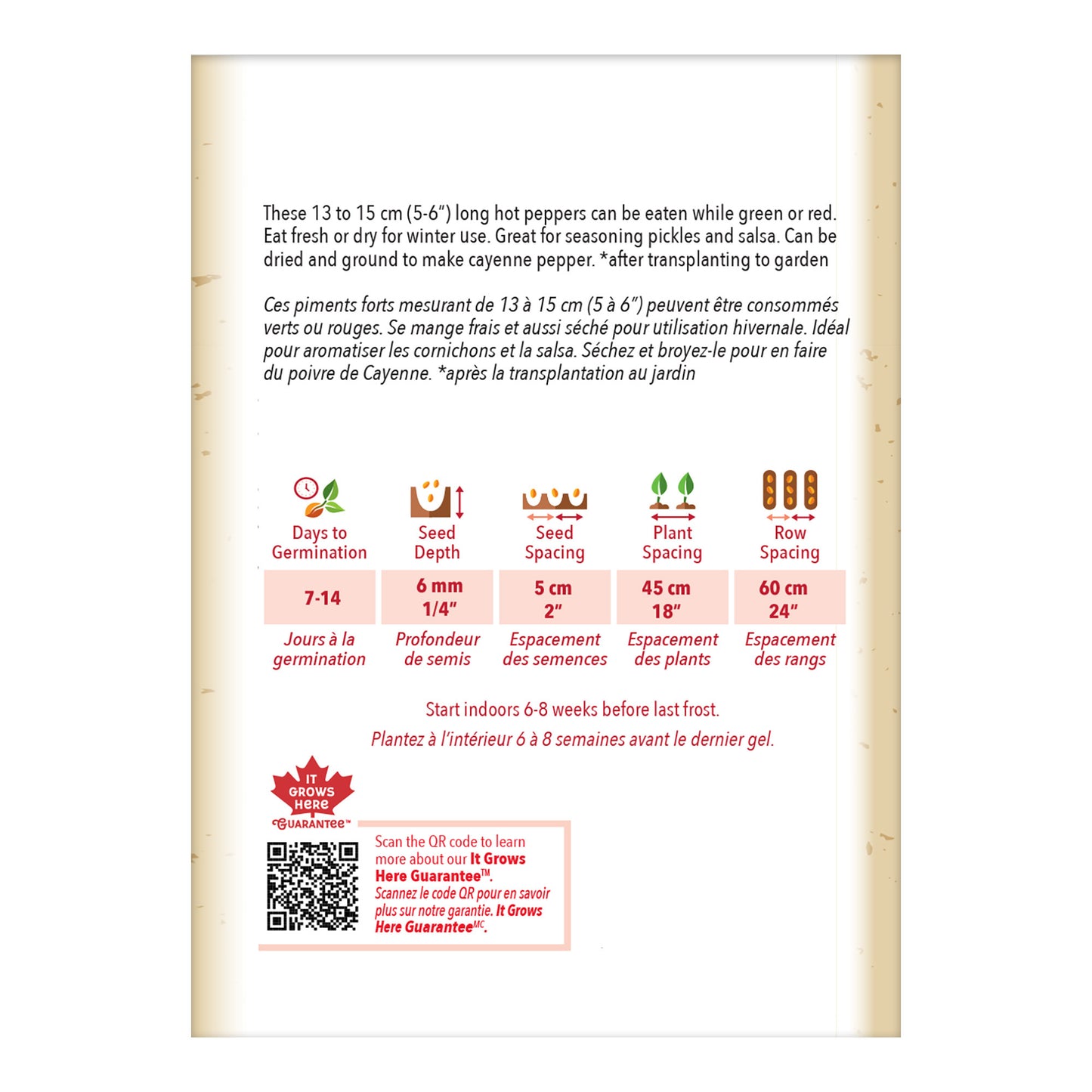30% off Seed Packets with code CYBER30 | View All Offers >
Pepper, Long Red Cayenne Organic Seeds
Earn 4 points for this item with our
rewards program.

Discover the vibrant heat and intense flavor of Long Red Cayenne Organic Pepper Seeds.
These 13 to 15 cm (5-6") long hot peppers can be eaten while green or red. Peppers need warm soil and night temperatures to prosper. Location should be sheltered from the wind and soil should be kept reasonably moist. This pepper variety produces slender, red peppers perfect for adding spice to sauces, salsas, and dried pepper flakes.
- SKU: 143609
- Common Name: Pepper
- Botanical Name: Capsicum annuum
Safe
for Bees
Grows
Best In:
Days to
Germination:
Water
Needs:
Days to
Maturity:
Best
Container Size:
- Plant Type: Vegetable
- Plant Lifecycle: Annual (plant every year)
- Seed Type: Open Pollinated
- Fill Weight (grams): 250 mg
- Approximate Seed Count: 25-30
- Characteristics: Container friendly | Frost-sensitive | Attracts songbirds
- Planting Method: Start Indoors
- Colour: Red
- Water Needs: Average 2.5-5 cm (1-2 in.) per week
- Landscape Use: Edible Garden
- Resistance: Deer
- Tolerance: Heat
- Companion Planting: Plant near basil, onions, oregano. Herbs such as basil and oregano possess a natural insect-repellent property that helps protect them from pests.
- Flavour: 30,000 - 50,000 SHU | Sizzling hot
- Preparation Ideas: Use fresh in sauces or chili.
-
Growing Instructions:
- Planting Depth: 6 mm (1/4in.)
- Seed Spacing: Sow pepper seeds roughly 5 cm (2 in.) apart in rows, keeping rows approximately 60 cm (24 in.) apart.
- Plant Spacing: 45 cm (18 in.)
- Instructions for Nutrient Care: Feed plants SUPERthrive once per week. Mix 1.2 ml (1/4 tsp) per 4L (1 gallon) of water in a watering can and apply solution to the base of the plants.
Start pepper seeds indoors 6 to 8 weeks before the last frost in your area. Follow the seed depth and spacing guidelines indicated below. Once all danger of frost has passed, seedlings should be hardened off before planting in their growing location. Seedlings should be transplanted according to the plant and row spacing directions below. Transplant seedlings into the garden once the soil temperature has reached 18°C (65°F). Pick a location sheltered from the wind. Pepper plants have brittle branches and it is a good idea to support plants at time of planting with a cage or stakes to prevent bending as they grow. Regularly monitor your plants and ensure that the soil remains moist , but not soggy while they establish themselves in their new environment.
- Plant peppers plants deeply - the bottom leaves on the stem should be just above the soil line to promote root development.
- Remove blossoms for the first couple of weeks to direct energy to growing the plant.
- Peppers are very temperature sensitive. Pollination may not occur if temperatures are below 15°C (60°F) and above 32°C (90°F). Use a shade cloth or row covers to avoid heat stress or sunscald (exposure to direct rays of the sun during hot weather, which will cause peppers to blister).
- Do not let pepper plants wilt because this will reduce the yield and quality of the fruit. Inconsistent watering also makes peppers susceptible to blossom-end rot.
- To harvest peppers without breaking brittle branches, cut off with a knife or pruning shears, leaving about 2.5 cm (1 in) of stem to prolong storage life.
- Use shade cloth or row covers to avoid heat stress or sunscald (exposure to direct rays of the sun during hot weather, which will cause peppers to get papery, blister, or get papery).
- Peppers are frost-sensitive and should be harvested before frost. If frost is expected, cover with a frost cover.
- Peppers contain capsaicin, an oily compound that produces heat. The hotter the pepper, the more capsaicin the peppers contain. Use gloves when handling hot peppers; do not touch your eyes or nose as capsaicin can burn skin.
- Peppers left to mature on the vine will normally turn from green – to yellow – to orange – and then red. As color changes, the flavor increases.
- Peppers should be picked often to encourage production. Peppers left too long on the plant will be soft and shriveled looking, and should be removed from the plant.





Pepper, Long Red Cayenne Organic Seeds
Register to receive a notification when this item comes back in stock.
Thanks! We'll let you know when this item is back in stock.
You may also like

Join our rewards program today to start saving!

Free Shipping on orders over $35

There are a ton of ways to earn!








